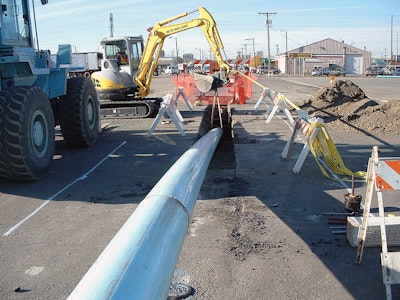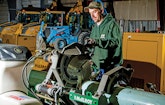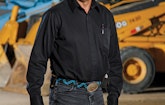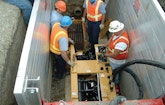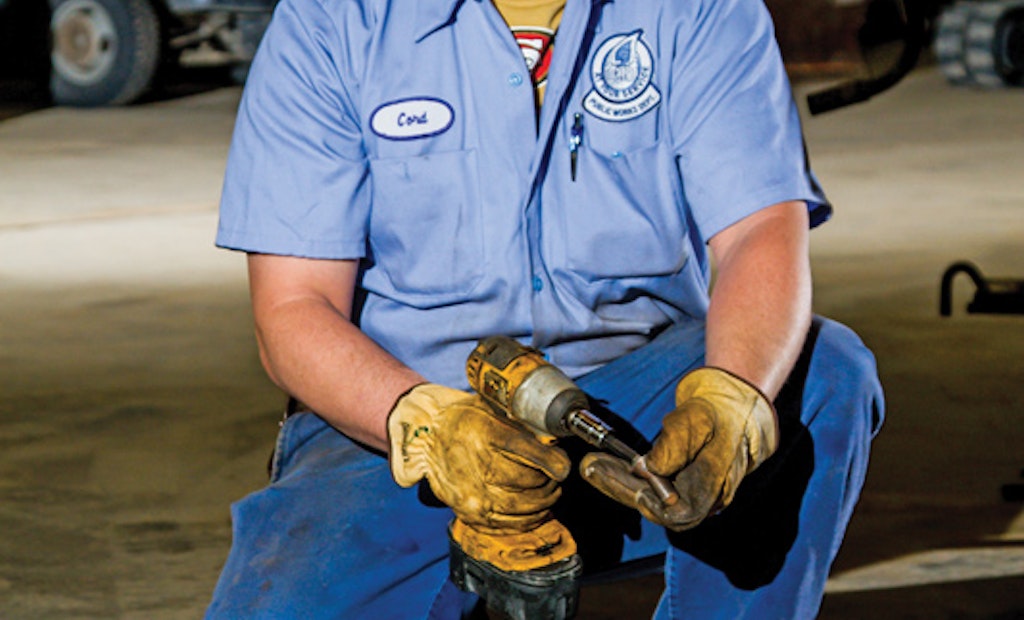
Interested in Rehab/Relining?
Get Rehab/Relining articles, news and videos right in your inbox! Sign up now.
Rehab/Relining + Get AlertsIn 2005, the city of Billings, Mont., got its first taste of pipe bursting technology. The early success of that effort has resulted in the creation of two in-house pipe bursting teams, one dedicated to sewer bursting and another to water.
The concept is simple. Construction crews dig an entry pit providing access to sewer or water lines. A bursting device is sent through the line requiring replacement. As it passes through, the device splits and bursts the existing pipe, while drawing new high-density polyethylene or polyvinyl chloride pipe behind it. The equipment can be divided into two major types. In pneumatic bursting, a soil displacing pneumatic hammer provides the force. In static pipe bursting, a cone-shaped head is pulled through the existing pipe with a pull rod assembly or cable. The equipment is then retrieved through an exit pit, or sewer manhole.
Billings is the largest city in the state, with just over 100,000 residents. The population is growing as a result of the city’s high-tech medical sector and proximity to the Bakken shale play to the east. Upsizing service to a growing city is now driving many pipe bursting projects.
The city’s water infrastructure is currently made of PVC, cast iron and ductile iron, with the oldest pipe dating back to the 1890s.
“The bulk of the system is in pretty good shape compared to other cities,” says Scott Emerick, superintendent of the Public Works Department Distribution and Collection Division. “We’ve stayed ahead of the curve by maintaining an assertive repair and replacement program since 1980. We had upwards of 200 leaks annually about 20 years ago. That’s now down to somewhere between 50 and 70.”
The sewer system is also in reasonable shape. However, flat terrain forces engineers to locate the pipes deep underground to create gravity flow. Some of the pipes are buried as far as 30 feet underground, making open-cut replacement a chore.
First efforts
“The first sewer pipe bursting job we did on our own was on 360 feet of 10-inch HDPE pipe replacing a 10-inch clay sewer,” recalls Emerick. “We rented the equipment from Vermeer Rocky Mountain in town. It took us about 24 hours to complete. Looking back, we saw our mistakes. One of the first lessons of pipe bursting is that when you start pulling the pipe through, you keep pulling until you’re finished. We stopped at the manhole when there were still a couple of feet left because the manhole wasn’t completely prepped. Starting back up was a challenge. We also didn’t use the right-sized air compressor to run the pipe bursting hammer.”
Even with the learning curve, Emerick estimated the cost of sewer installation at around $45 a foot, considerably cheaper than contracting work to outside firms. The cost of water pipe bursting was estimated at $40 to $140 a foot, depending on the level of service restoration, compared to contractor pricing of $200 to $300 per foot.
“The equipment vendor at Vermeer Rocky Mountain mentioned he could sell us a static HydroBurst HB100 system by HammerHead Trenchless Equipment,” says Emerick. “We pulled some numbers together and gave it to our utility director. We explained that as our crews got more practice, the costs would go down. When we presented our preliminary numbers to city council, they amended our budget and we got approval to purchase our pipe bursting rig and a HammerHead Mole pneumatic piercing tool in 2006.”
Emerick notes that utilities considering such an investment should budget for additional equipment beyond the basic tools. The Billings order included a HammerHead winch and power pack, a McElroy Manufacturing 412 fusion machine, an Ingersoll Rand air compressor and a Kiefer Manufacturing telescoping trailer, capable of delivering 40-foot pipe lengths to work sites. A mini-excavator and pipe testing equipment rounded out the buy.
Cutting its teeth on water
The utility cut its teeth on water pipe bursting in 2007 after farming out a few projects to Mr. Pipetech, a contractor located in Miles City. The job: a 300-foot pull, replacing 4-inch cast iron with 6-inch HDPE pipe.
“Again, we learned a lesson,” says Emerick. “HDPE takes a different type of water fitting than fusible PVC, which was compatible with our system. Working with HDPE on water would require us to stock a whole new set of fittings and taps than we were using for our existing bell and spigot PVC pipe. HDPE is still great for sewer work.”
In 2008, the department targeted 520 feet of 8-inch cast-iron water pipe for replacement and upsizing to 12-inch. Instead of HDPE, Billings went with Fusible C-900 PVC pipe from Underground Solutions Inc. of Poway, Calif.
“For a lot of people who do water pipe bursting, this pipe brand is the ticket,” says Emerick. “However, if you install their product, they require you to undergo company training and become a licensed installer. You need to record each pipe fusion and give them a copy of the work for their records to ensure quality control.”
Initially, all bursting equipment was placed under the supervision of now-retired foreman Jim Burnham. Sewer maintenance supervisor Scott White recalls that the work team would concentrate on one job at a time.
“Jim would pound in the water pipes and replace them, while we would follow and restore services and other connections,” he says. “However, under that approach, the sewer bursting equipment would sit idle while we worked on water.”
Two new teams
White recommended that the department divide pipe bursting duties between two dedicated teams of four, including a supervisor. That happened in 2010 with White now heading up the sewer pipe bursting team, while maintenance supervisor J.R. Fox leads the water pipe bursting team. Outfitting both teams required the purchase of an additional pickup truck, mini-excavator, skid steer and trenchboxes, but resulted in greater efficiency.
The utility has found that project schedules work out best when entry and exit pits are excavated as much as a week in advance. Replacement pipe is fused as much as a day before the bursting project. Pushrods are also assembled prior to water line bursting projects.
Fox advises first-time pipe bursters to carve out an adequate staging area prior to commencing the job.
“Watch your footprint when you’re bringing in a stack of 40-foot pipes,” he says. “Finding the room to place everything on site can be a burden, although customers are often willing to work with us.”
Fox notes that pre-digging holes to reinstate water service provided no additional project benefits. “We found that pulling the pipe through tended to cave in the holes we had just dug,” he says. “We were digging the same hole twice.”
White recommends that utilities concentrate on project design and adequate preparation. “The burst is really the easy part,” he says. Pipe projects are usually handled in 400-foot increments, which require about 90 minutes to pull.
Sewer projects are extensively televised prior to bursting, using an RapidView IBAK sewer camera. Customer sewers remain live during the pull, so lateral services are quickly restored, then televised again.
Leveraging in-house expertise
All aspects of the projects are handled in-house, except for the provision of temporary water services to residents and businesses. An outside contractor lays out 20-inch PVC pipe to provide the temporary service.
Once the new water line has been pulled, the utility conducts a two-hour pressure test, followed by water sampling at 24 and 48 hours before water service is restored.
The utility has recently begun to push the limits of water pipe bursting technology by stepping out of its comfort zone of installing 8-inch replacement pipe.
“We experimented with 12-inch pipe in an industrial area, but had some issues with the fusion of the PVC pipe,” says Emerick. “The 12-inch line pushes the fusion machine to its limits. The work was slow, but results were good. If we work on a similar project, we’d likely buy a McElroy 618 fusion machine designed to handle larger pipe.”
Prime time for pipe bursting in Billings is spring, summer and early fall. When Montana’s frigid winters approach in November, pipe bursting is suspended.
“It’s not easy to get through the asphalt in the winter where the first 2 feet of ground is frozen,” say Emerick. “As winter progresses, that expands to 3 to 4 feet deep. Winter is also not a good time to provide temporary water lines to customers. At 20 degrees below zero this is just not going to happen.”
Maintenance time
During downtime, crews perform equipment maintenance, checking hydraulic systems and greasing moving parts. The utility also plans ahead, submitting construction drawings of proposed pipe bursting projects to the Montana Department of Environmental Quality, so work can begin immediately following spring thaw.
This year, the utility replaced about 2,000 feet of water pipe and 7,000 feet of sewer pipe, a total that fell a little below average due to the technical difficulties encountered during the 12-inch industrial water project.
While city bean counters remain appreciative of the in-house effort, most customers remain unaware of the technology being used.
“The real pay-off for customers occurs when they’re waiting for the excavator to tear up their streets and properties,” says Fox. “There’s a lot of relief when they realize they can get in and out of their driveways with ease.”
